Shape Memory Properties and Microstructure of New Iron-Based FeNiCoAlTiNb Shape Memory Alloys
Abstract
:1. Introduction
2. Materials and Methods
- (1)
- Solution heat treatment (SHT 1) at 1277 °C for 24 h (h), followed by water quench (WQ). The first stage of solution heat treatment was used to homogenize the alloys;
- (2)
- Cold rolling (CR) at room temperature with a reduction ratio of 97% to a thickness of 0.7 mm, and three-point bending samples were cut from the cold-rolled sheet;
- (3)
- Solution heat treatment (SHT 2) at 1277 °C for 1h and water quenching;
- (4)
- Aging or precipitation heat treatment (PHT) at 600 °C for 24, 48 and 72h to introduce L12 precipitates and water quenching. For the sake of brevity, we refer to the alloys aged at 600 °C for x hours as “600 °C–h”.
3. Results
3.1. Microstructure and Microhardness Results
3.2. XRD Results
3.3. Magnetization Results
3.4. EBSD and ODFs Results
3.5. Three-Point Bending Test Results
4. Discussion
5. Conclusions
- (1)
- The β phases were generated along the grain boundaries when the aging times were 48 and 72 h at 600 °C. The XRD results of cold-rolled samples after 1277 °C–1 h showed a strong peak intensity in the (111) plane.
- (2)
- The cold-rolled sample aged at 600 °C for 24, 48 and 72 h showed phase transformation under the magnetic field of 0.05 and 7 Tesla. As the aging durations were increased from 24 to 72 h, the martensitic transformation temperature shifted to a higher temperature, which indicates the transformation temperatures increase with an increase in the aging times.
- (3)
- Recrystallization textures of near <100> orientation were developed using a combination of cold rolling with a reduction ratio of 97% and subsequent annealing at 1277 °C for 1 h. The average grain size was around 400 μm, and the intensity of texture was 13.64.
- (4)
- Shape memory behavior was not observed in the 600 °C–24 h sample at a 2000 MPa stress level due to the fact that it possessed the lowest transformation temperature. The shape memory properties in the 600 °C–48 h sample with a recoverable strain of 1.6% at 200 MPa stress level were obtained using a three-point bending test. The observed recoverable strain values were lower than the theoretical values, possibly owing to the smaller fraction of low angle grain boundary, the formation of grain boundary precipitates and grain boundary constraint due to a slightly lower than expected intensity of texture in the samples. The thermal hysteresis was around 40 °C. The recoverable strain in the 600 °C–72 h sample was 1.1% at 100 MPa. The sample fractured at a stress level of 150 MPa due to the formation of a large amount of brittle β phases.
Author Contributions
Funding
Acknowledgments
Conflicts of Interest
References
- Otsuka, K.; Wayman, C.M. Shape Memory Materials; Cambridge University Press: Cambridge, UK, 1998; pp. 117–132. [Google Scholar]
- Jani, J.M.; Leary, M.; Subic, A.; Gibson, M.A. A review of shape memory alloy research, applications and opportunities. Mater. Des. 2014, 56, 1078–1113. [Google Scholar] [CrossRef]
- Omori, T.; Kainuma, R. Martensitic transformation and superelasticity in Fe-Mn-Al-Based shape memory alloys. Shape Mem. Superelasticity 2017, 3, 334–355. [Google Scholar] [CrossRef] [Green Version]
- Khalil, W.; Mikolajczak, A.; Bouby, C.; Zineb, T.B. A constitutive model for Fe-based shape memory alloy considering martensitic transformation and plastic sliding coupling: Application to a finite element structural analysis. J. Intell. Mater. Syst. Struct. 2012, 23, 1143–1160. [Google Scholar] [CrossRef]
- Maki, T.; Kobayashi, K.; Minato, M.; Tamura, I. Thermoelastic martensite in an ausaged Fe-Ni-Ti-Co alloy. Scr. Metall. 1984, 18, 1105–1109. [Google Scholar] [CrossRef]
- Sehitoglu, H.; Karaman, I.; Zhang, X.; Chumlyakov, Y.; Maier, H.J. Deformation of FeNiCoTi shape memory single crystals. Scr. Mater. 2001, 44, 779–784. [Google Scholar] [CrossRef]
- Sehitoglu, H.; Zhang, X.Y.; Kotil, T.; Canadinc, D.; Chumlyakov, Y.; Maier, H.J. Shape memory behavior of FeNiCoTi single and polycrystals. Metall. Mater. Trans. A 2002, 33, 3661–3672. [Google Scholar] [CrossRef]
- Tanaka, Y.; Himuro, Y.; Kainuma, R.; Sutou, Y.; Omori, T.; Ishida, K. Ferrous polycrystalline shape-memory alloy showing huge superelasticity. Science 2010, 27, 1488–1490. [Google Scholar] [CrossRef]
- Omori, T.; Abe, S.; Tanaka, Y.; Lee, D.; Ishida, K.; Kainuma, R. Thermoelastic martensitic transformation and superelasticity in Fe-Ni-Co-Al-Nb-B polycrystalline alloy. Scr. Mater. 2013, 69, 812–815. [Google Scholar] [CrossRef]
- Lee, D.; Omori, T.; Kainuma, K. Ductility enhancement and superelasticity in Fe-Ni-Co-Al-T-B polycrystalline alloy. J. Alloy. Compd. 2014, 617, 120–123. [Google Scholar] [CrossRef]
- Otsuka, H.; Yamada, H.; Maruyama, T.; Tanahashi, H.; Matsuda, S.; Murakami, H. Effects of alloying additions on Fe-Mn-Si shape memory alloys. ISIJ Int. 1990, 30, 674–679. [Google Scholar] [CrossRef] [Green Version]
- Sato, A.; Chishima, E.; Yamaji, Y.; Mori, T. Orientation and composition dependencies of shape memory effect in Fe-Mn-Si Alloys. Acta Metall. 1984, 32, 539–547. [Google Scholar] [CrossRef]
- Ando, K.; Omori, T.; Ohnuma, T.; Kainuma, R.; Ishida, K. Ferromagnetic to weak-magnetic transition accompanied by bcc to fcc transformation in Fe-Mn-Al alloy. Appl. Phys. Lett. 2009, 95, 212504. [Google Scholar] [CrossRef]
- Omori, T.; Watanabe, K.; Umetsu, R.Y.; Kainuma, R.; Ishida, K. Martensitic transformation and magnetic field-induced strain in Fe-Mn-Ga shape memory alloy. Appl. Phys. Lett. 2009, 95, 082508. [Google Scholar] [CrossRef]
- Zhu, W.; Liu, E.K.; Feng, L.; Tang, X.D.; Chen, J.L.; Wu, G.H.; Liu, H.Y.; Meng, F.B.; Luo, H.Z. Magnetic-field-induced transformation in FeMnGa alloys. Appl. Phys. Lett. 2009, 95, 222512. [Google Scholar] [CrossRef]
- Omori, T.; Ando, K.; Okano, M.; Xu, X.; Tanaka, Y.; Ohnuma, I.; Kainuma, R.; Ishida, K. Superelastic effect in polycrystalline ferrous alloys. Science 2011, 333, 68–71. [Google Scholar] [CrossRef] [PubMed]
- Sawaguchi, T.; Maruyama, T.; Otsuka, H.; Kushibe, A.; Inoue, Y.; Tsuzaki, K. Design concept and applications of Fe-Mn-Si-based alloys -from shape-memory to seismic response control. Mater. Trans. 2016, 57, 283–293. [Google Scholar] [CrossRef] [Green Version]
- Geng, Y.; Lee, D.; Xu, X.; Nagasako, M.; Jin, X.; Omori, T.; Kainuma, R. Coherency of ordered γ’ precipitates and thermoelastic martensitic transformation in FeNiCoAlTaB alloys. J. Alloy. Compd. 2015, 628, 287–292. [Google Scholar] [CrossRef]
- Fu, H.; Zhao, H.; Shilei, S.; Zhang, Z.; Xie, J. Evolution of the cold-rolling and recrystallization textures in FeNiCoAlNbB shape memory alloy. J. Alloy. Compd. 2016, 628, 287–292. [Google Scholar] [CrossRef]
- Ma, J.; Kockar, B.; Evirgen, A.; Karaman, I.; Luo, Z.; Chumlyakov, Y. Shape memory behavior and tension–compression asymmetry of a FeNiCoAlTa single-crystalline shape memory alloy. Acta Mater. 2012, 60, 2186–2195. [Google Scholar] [CrossRef]
- Ma, J.; Hornbuckle, B.; Karaman, I.; Thompson, G.B.; Luo, Z.; Chumlyakov, Y. The effect of nanoprecipitates on the superelastic properties of FeNiCoAlTa shape memory alloy single crystals. Acta Mater. 2013, 61, 3445–3455. [Google Scholar] [CrossRef]
- Krooß, P.; Holzweissig, M.J.; Niendorf, T.; Somsen, C.; Schaper, M.; Chumlyakov, Y.I.; Maier, H.J. Thermal cycling behavior of an aged FeNiCoAlTa single-crystal shape memory alloy. Scr. Mater. 2014, 81, 28–31. [Google Scholar] [CrossRef]
- Tseng, L.W.; Ma, J.; Karaman, I.; Wang, S.J.; Chumlyakov, Y. Superelastic response of the FeNiCoAlTi single crystals under tension and compression. Scr. Mater. 2015, 101, 1–4. [Google Scholar] [CrossRef]
- Chumlyakov, Y.I.; Kireeva, I.V.; Kutz, O.A.; Turabi, A.S.; Karaca, H.E.; Karaman, I. Unusual reversible twinning modes and giant superelastic strains in FeNiCoAlNb single crystals. Scr. Mater. 2016, 119, 43–46. [Google Scholar] [CrossRef]
- Choi, W.S.; Pang, E.L.; Choi, P.P.; Schuh, C.A. FeNiCoAlTaB superelastic and shape-memory wires with oligocrystalline grain structure. Scr. Mater. 2020, 188, 1–5. [Google Scholar] [CrossRef]
- Abuzaida, W.; Sehitoglu, H. Shape memory effect in FeMnNiAl iron-based shape memory alloy. Scr. Mater. 2019, 169, 57–60. [Google Scholar] [CrossRef]
- Vollmer, M.; Arold, T.; Kriegel, M.J.; Klemm, V.; Degener, S.; Freudenberger, J.; Niendorf, T. Promoting abnormal grain growth in Fe-based shape memory alloys through compositional adjustments. Nat. Commun. 2019, 10, 2337. [Google Scholar] [CrossRef] [Green Version]
- Omori, T.; Okano, M.; Kainuma, R. Effect of grain size on superelasticity in Fe-Mn-Al-Ni shape memory alloy wire. APL Mater. 2013, 1, 032103. [Google Scholar] [CrossRef]
- Ozcan, H.; Ma, J.; Wang, S.J.; Karaman, I.; Chumlyakov, Y.; Brown, J.; Noebe, R.D. Effects of cyclic heat treatment and aging on superelasticity in oligocrystalline Fe-Mn-Al-Ni shape memory alloy wires. Scr. Mater. 2017, 134, 66–70. [Google Scholar] [CrossRef] [Green Version]
- Ozcan, H.; Ma, J.; Karaman, I.; Chumlyakov, Y.I.; Santamarta, R.; Brown, J.; Noebe, R.D. Microstructural design considerations in Fe-Mn-Al-Ni shape memory alloy wires: Effects of natural aging. Scr. Mater. 2018, 142, 153–157. [Google Scholar] [CrossRef]
- Tseng, L.W.; Ma, J.; Wang, S.J.; Karaman, I.; Kaya, M.; Luo, Z.P.; Chumlyakov, Y.I. Superelastic response of a single crystalline FeMnAlNi shape memory alloy under tension and compression. Acta Mater. 2015, 89, 374–383. [Google Scholar] [CrossRef]
- Tseng, L.W.; Ma, J.; Hornbuckle, B.; Karaman, I.; Thompson, G.B.; Luo, Z.; Chumlyakov, Y. The effect of precipitates on the superelastic response of [100] oriented FeMnAlNi single crystals under compression. Acta Mater. 2015, 97, 234–244. [Google Scholar] [CrossRef] [Green Version]
- Zhang, C.; Zhu, C.; Shin, S.; Casalena, L.; Vecchio, K. Multifunctional non-equiatomic high entropy alloys with superelastic, high damping, and excellent cryogenic properties. Adv. Eng. Mater. 2019, 21, 1800941. [Google Scholar] [CrossRef] [Green Version]
- Czerny, M.; Cios, G.; Maziarz, W.; Chumlyakov, Y.; Chulist, R. Studies on the two-step aging process of Fe-based shape memory single crystals. Materials 2020, 13, 1724. [Google Scholar] [CrossRef] [Green Version]
- Czerny, M.; Maziarz, W.; Cios, G.; Wojcik, A.; Chumlyakov, Y.I.; Schell, N.; Fitta, M.; Chulist, R. The effect of heat treatment on the precipitation hardening in FeNiCoAlTa single crystals. Mater. Sci. Eng. A 2020, 784, 139327. [Google Scholar] [CrossRef]
- Chumlyakov, Y.I.; Kireeva, I.V.; Pobedennaya, P.; Krooβ, P.; Niendorf, T. Rubber-like behaviour and superelasticity of [1]-oriented FeNiCoAlNb single crystals containing γ- and β-phase particles. J. Alloy. Compd. 2021, 856, 158158. [Google Scholar] [CrossRef]
- Chumlyakov, Y.I.; Kireeva, I.V.; Kuksgauzen, D.A.; Niendorf, T.; Krooβ, P. Tension-compression asymmetry of the superelastic behavior of high-strength [1]-oriented FeNiCoAlNb crystals. Mater. Lett. 2021, 289, 129395. [Google Scholar] [CrossRef]
- Chumlyakov, Y.I.; Kireeva, I.V.; Pobedennaya, Z.V.; Krooβ, P.; Niendorf, T. Shape memory effect and superelasticity of [1]-oriented FeNiCoAlNb single crystals aged under and without stress. Metals 2021, 11, 943. [Google Scholar] [CrossRef]
- Poklonov, V.; Chumlyakov, Y.; Kireeva, I.; Lyamkind, S. Thermoelastic martensitic transformation in single crystals of FeNiCoAlTiNb alloy. AIP Conf. Proc. 2017, 1909, 020174. [Google Scholar]
- Tseng, L.W.; Tzeng, Y.C.; Tsai, Y.L.; Chumlyakov, Y.I. Microstructure investigation of new iron-based FeNiCoAlTiNb shape memory alloys. Results Mater. 2021, 10, 1001881–1001887. [Google Scholar]
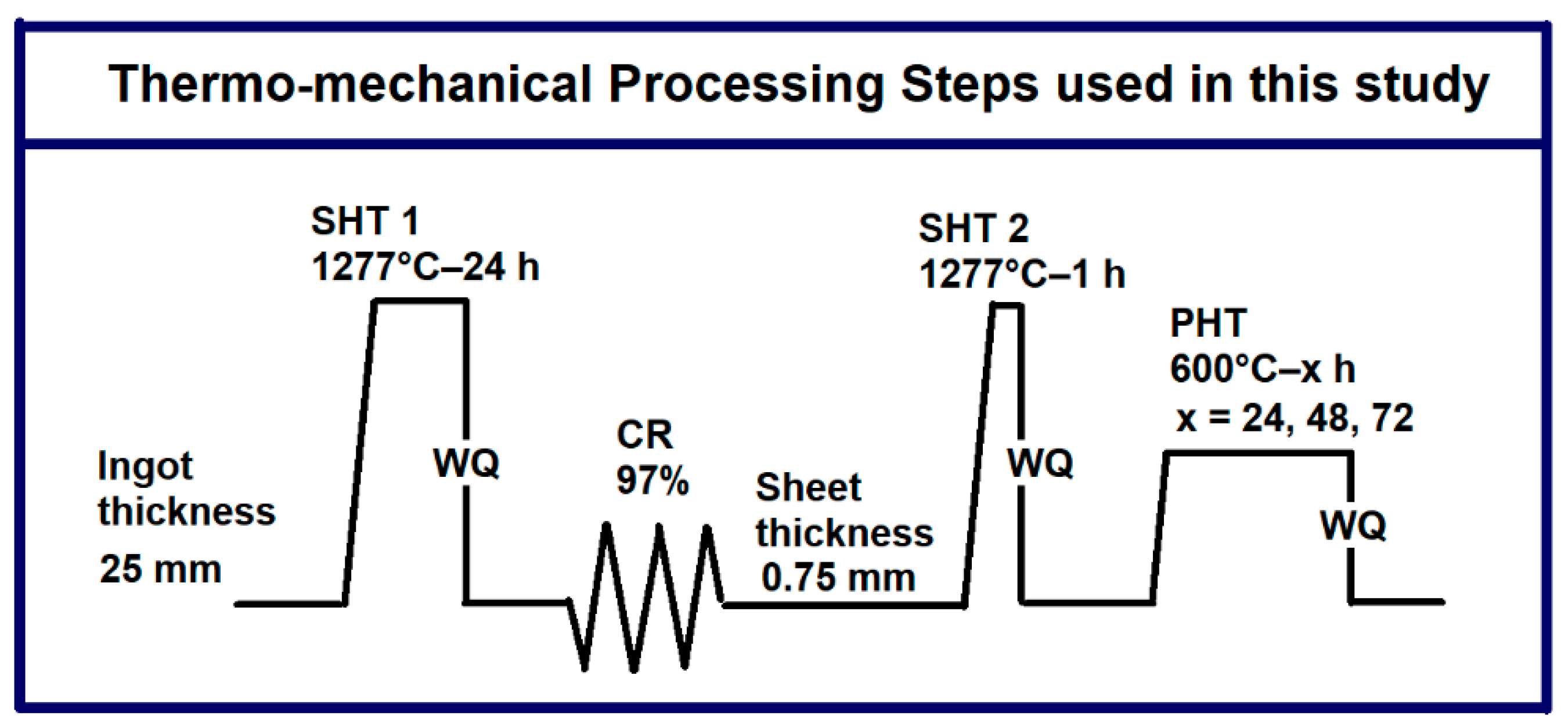
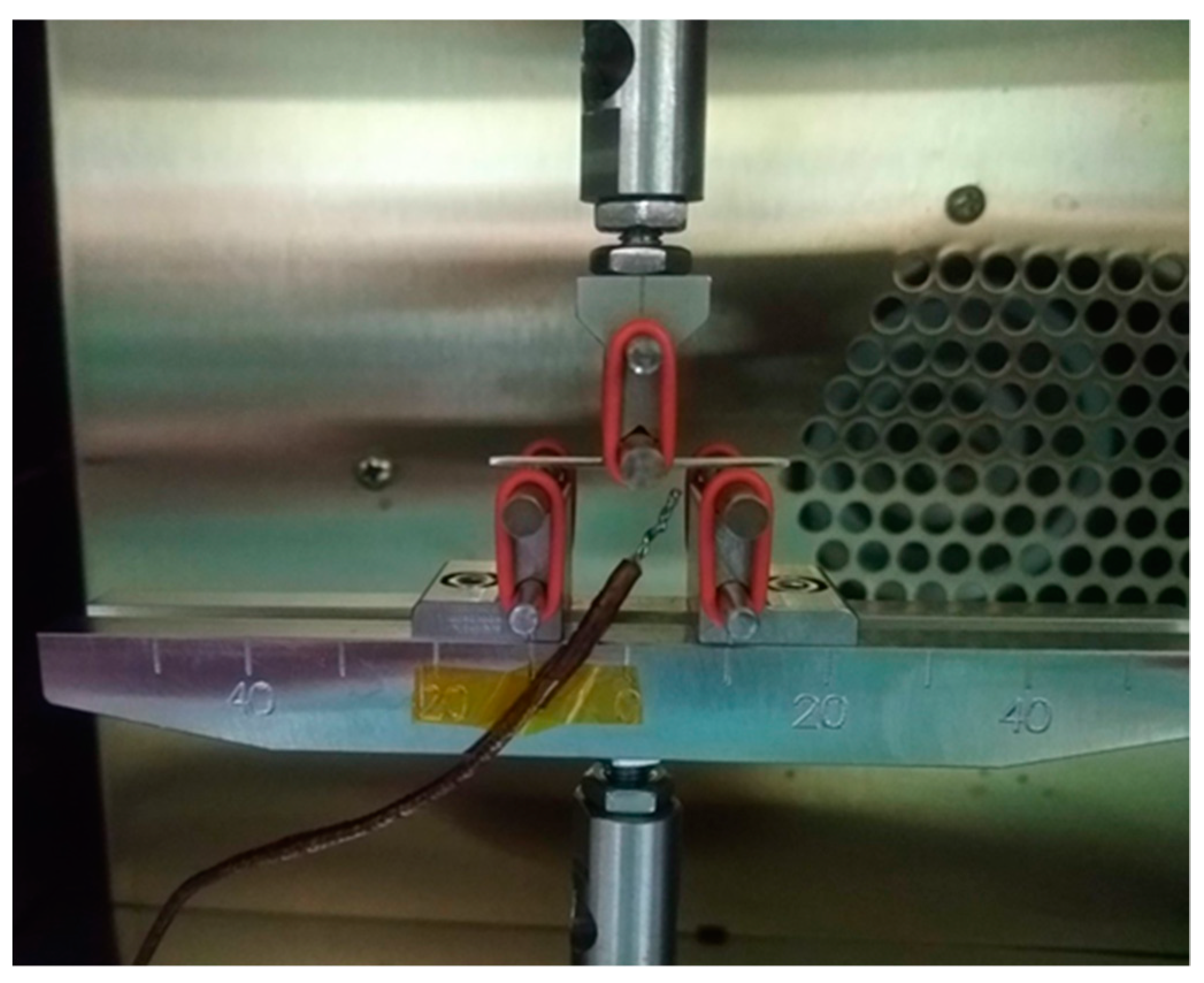
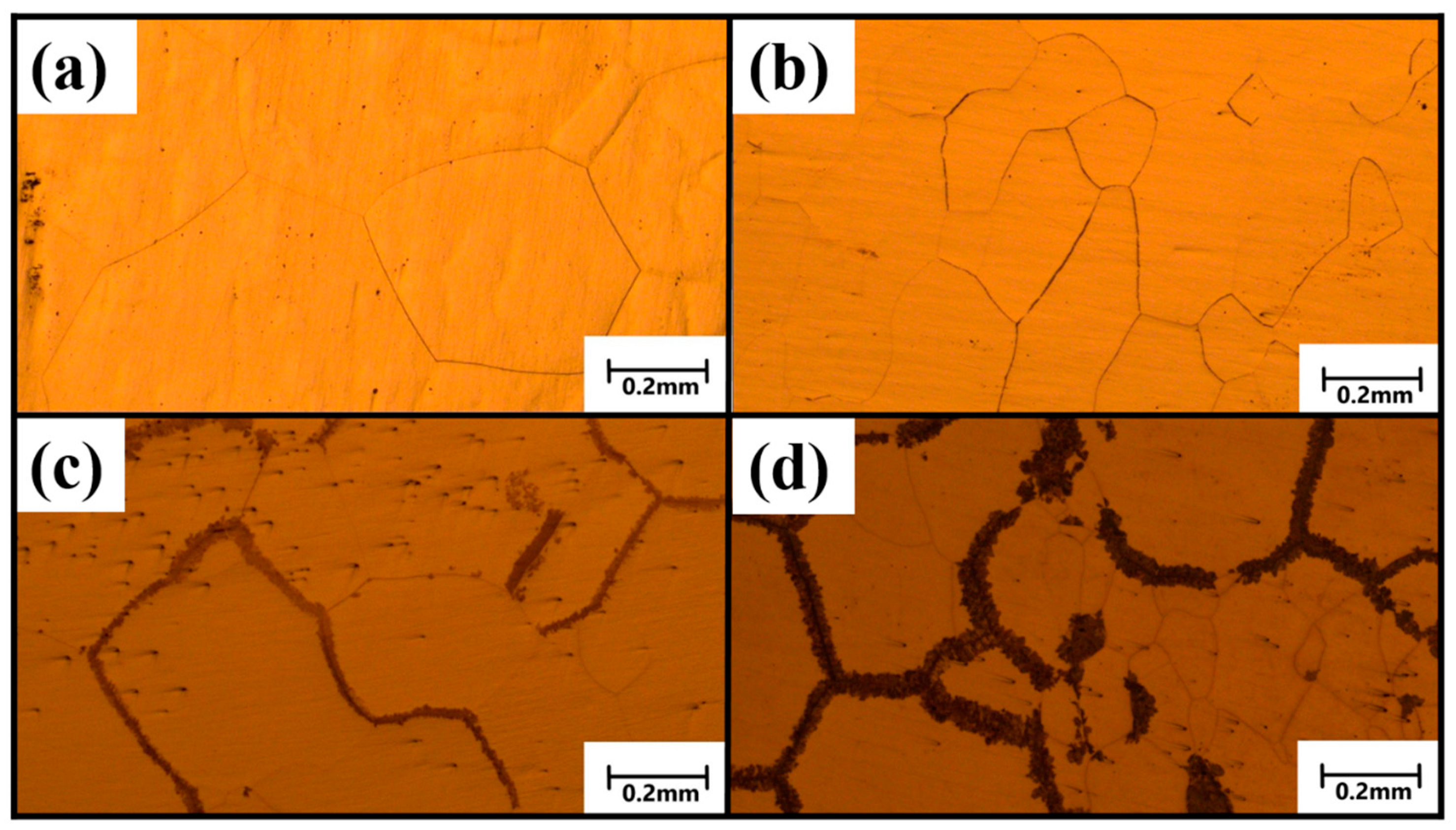
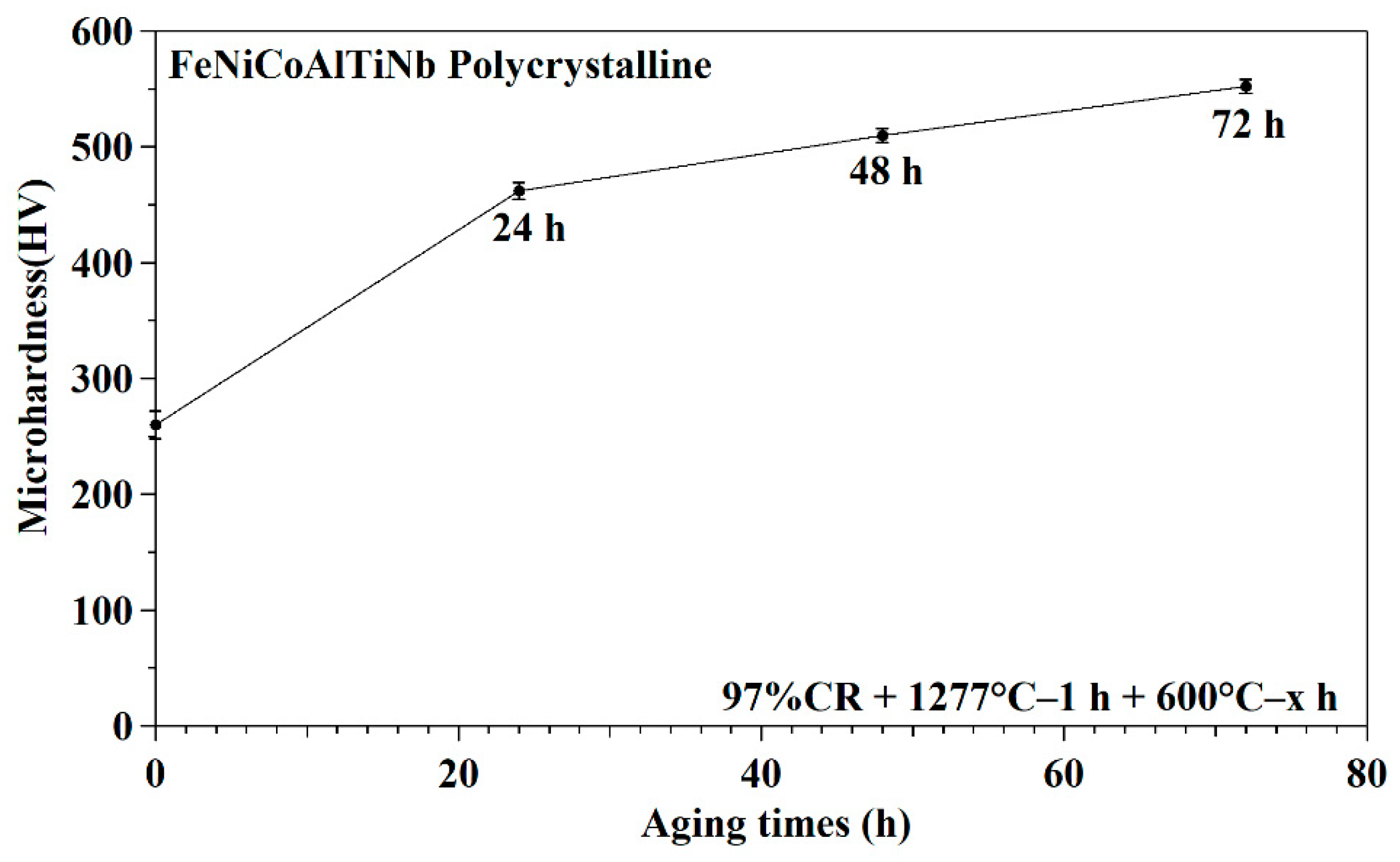
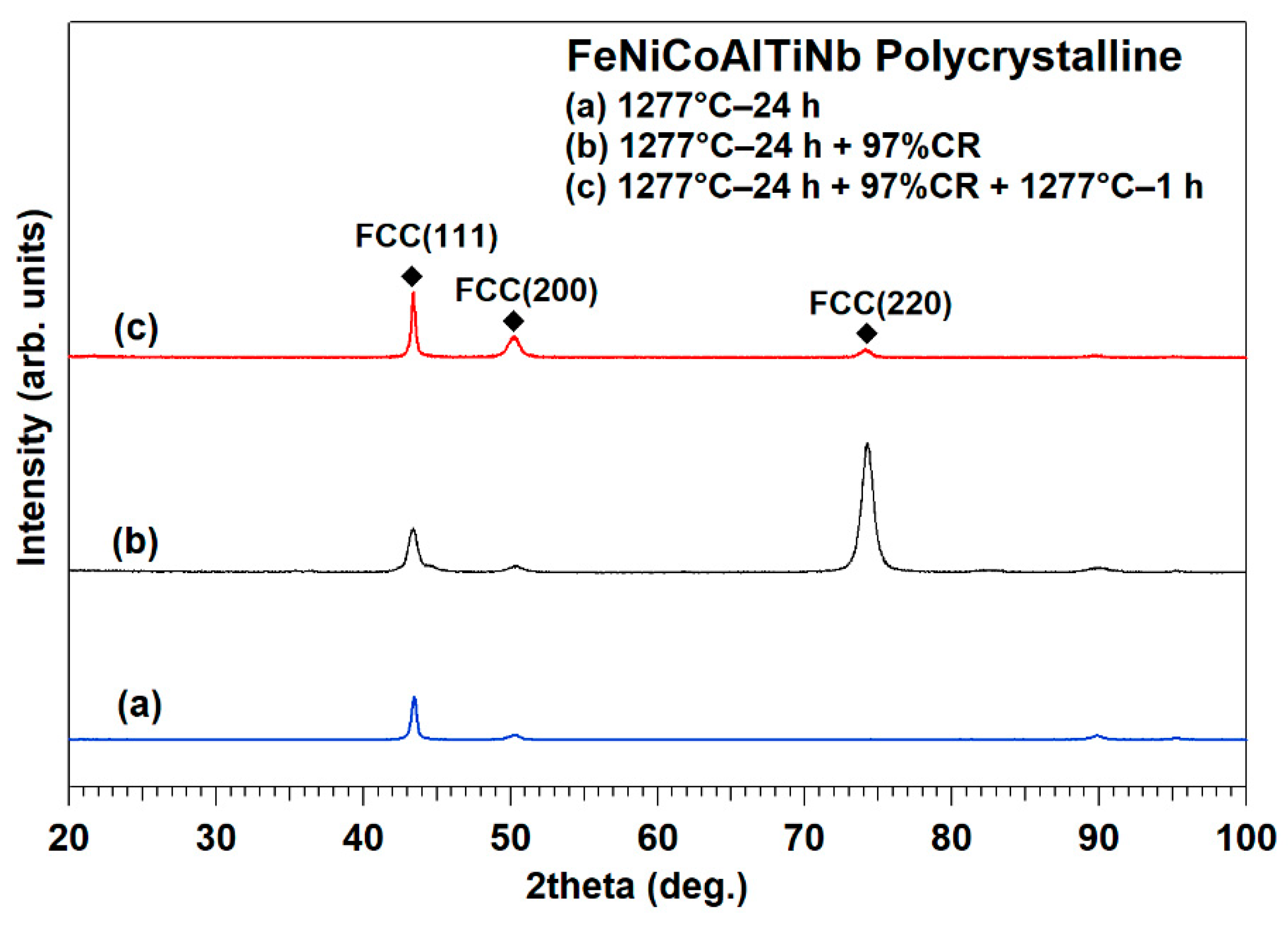

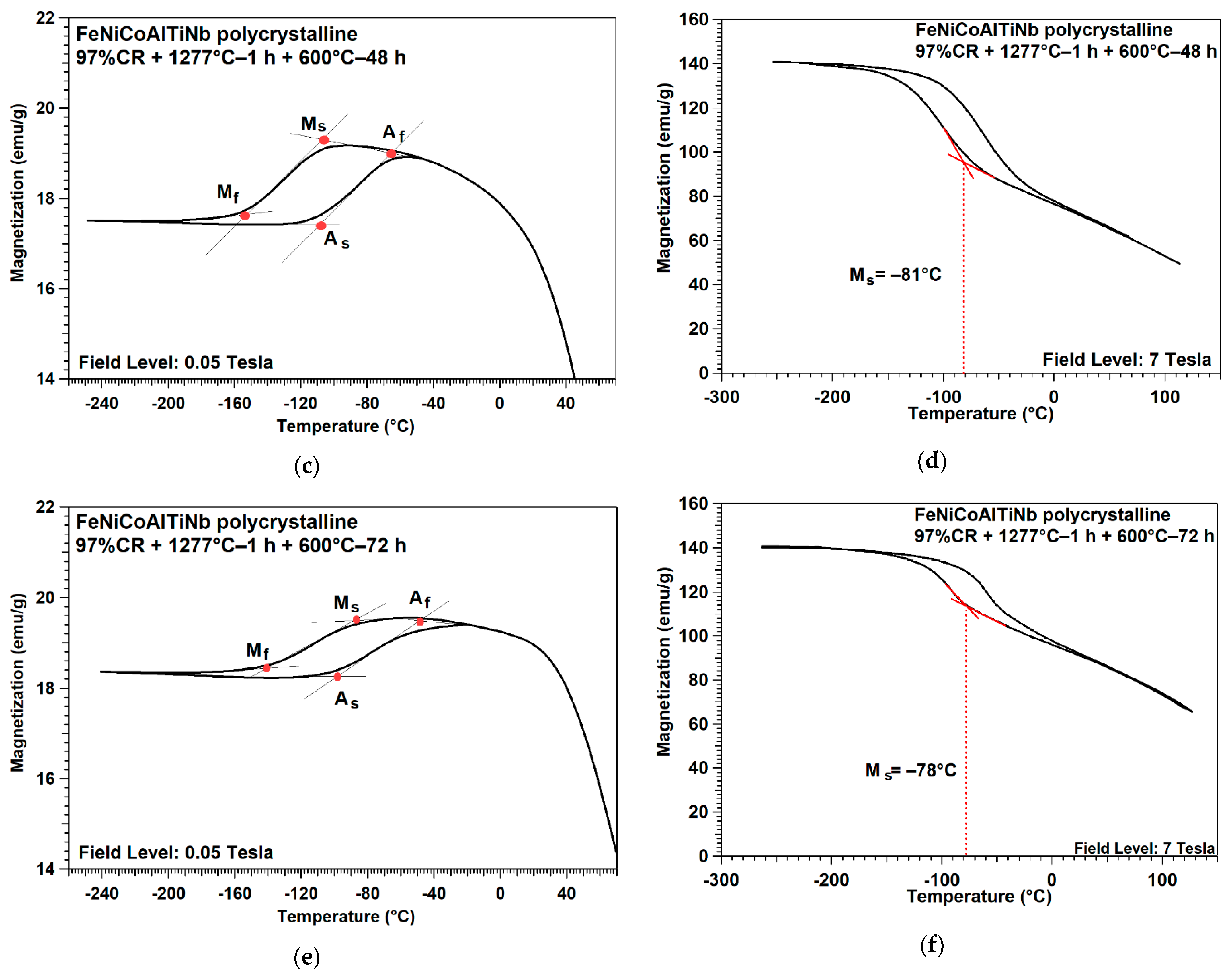
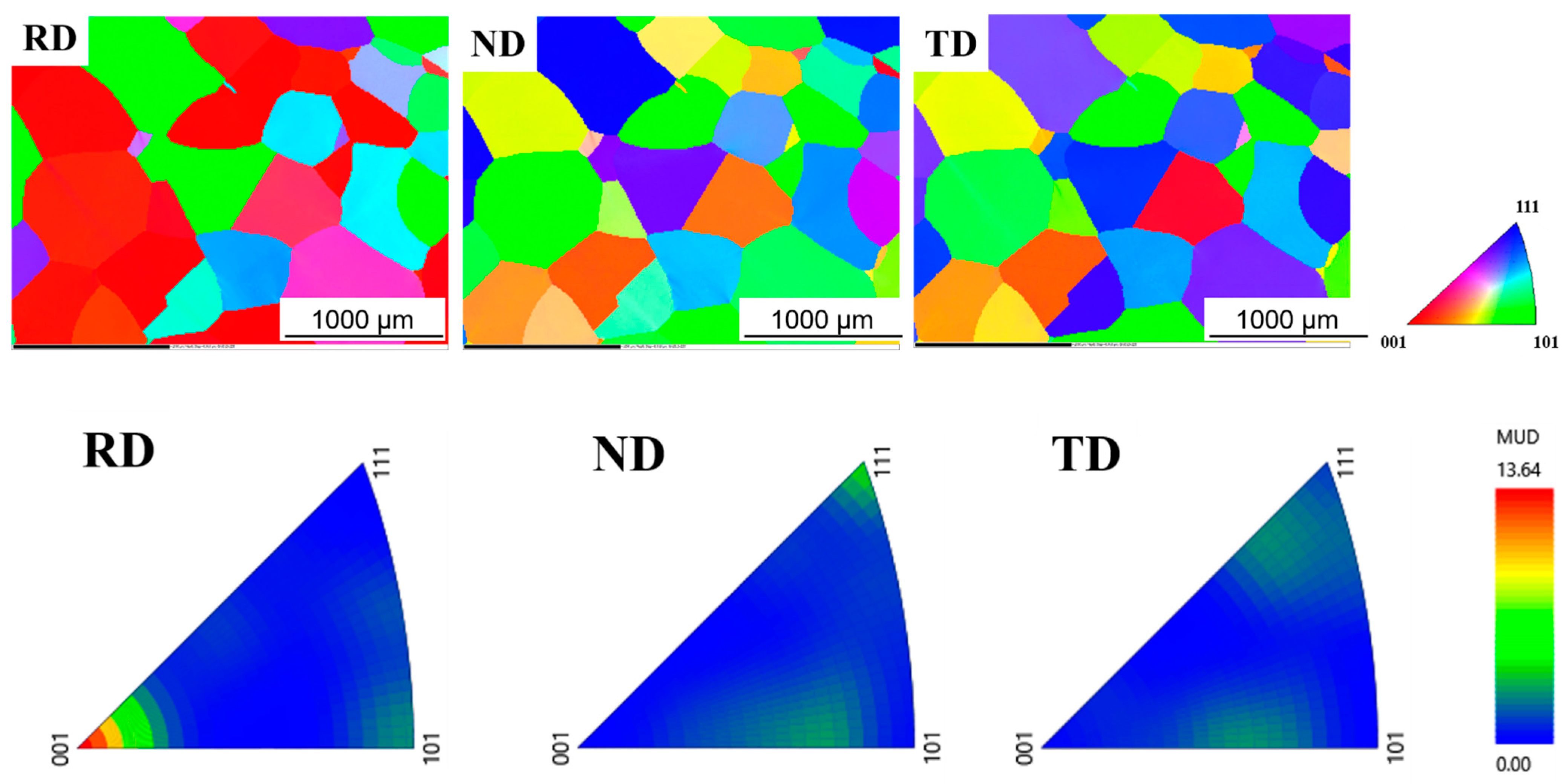
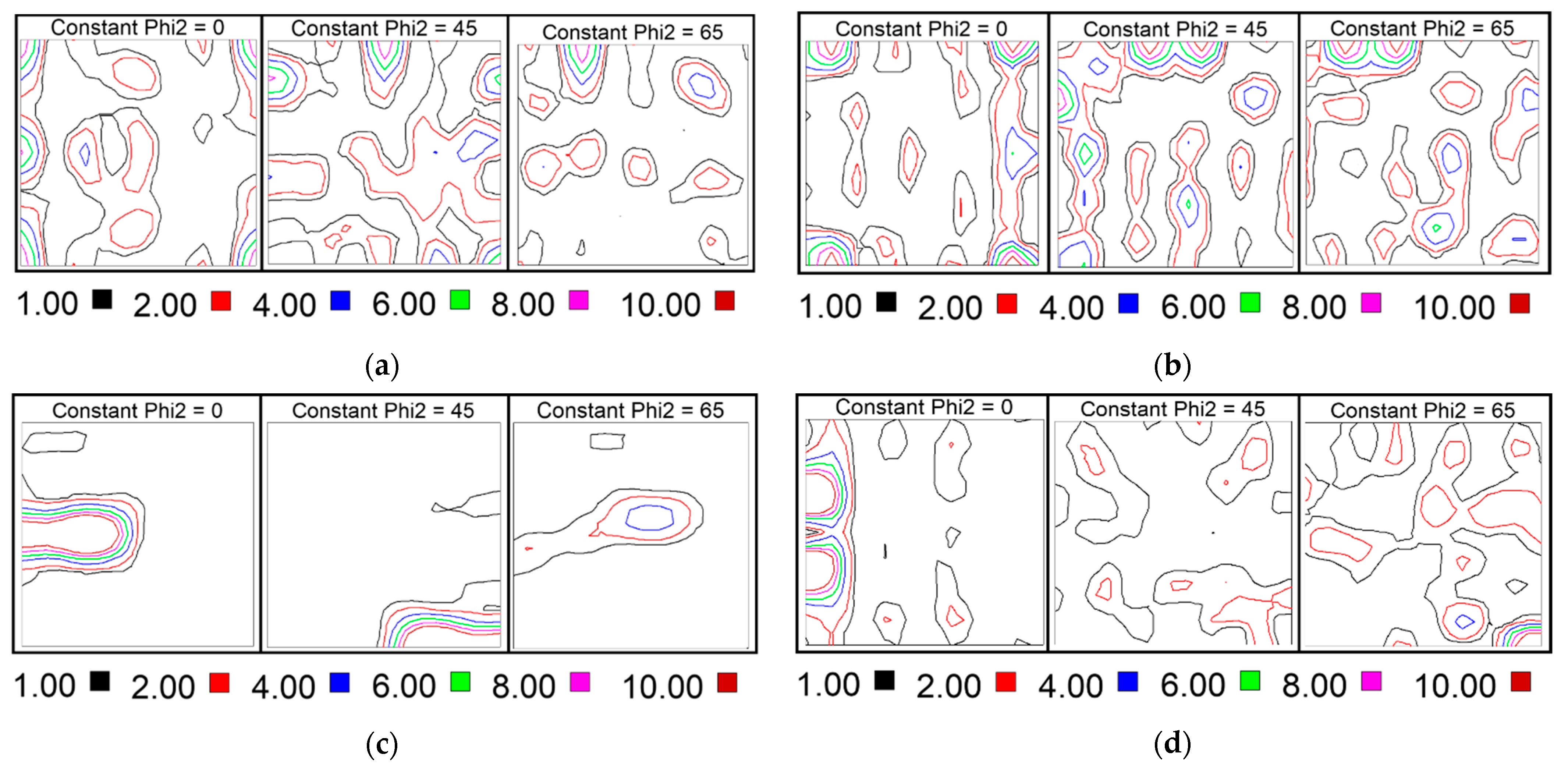
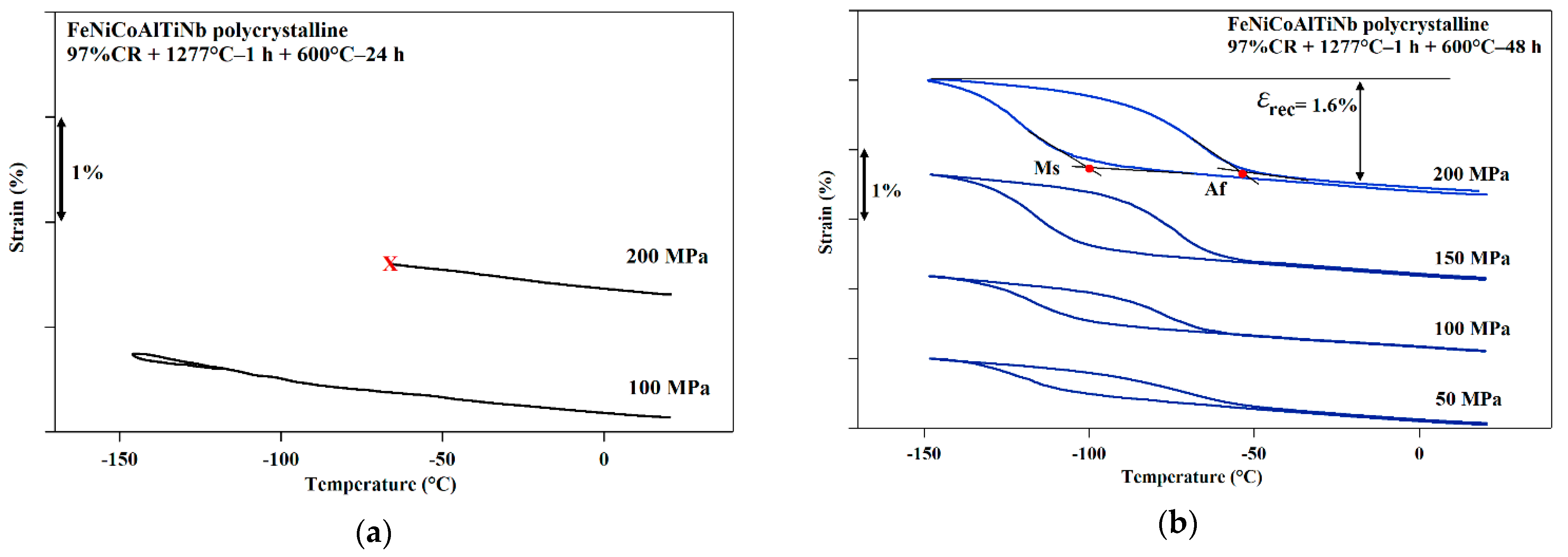

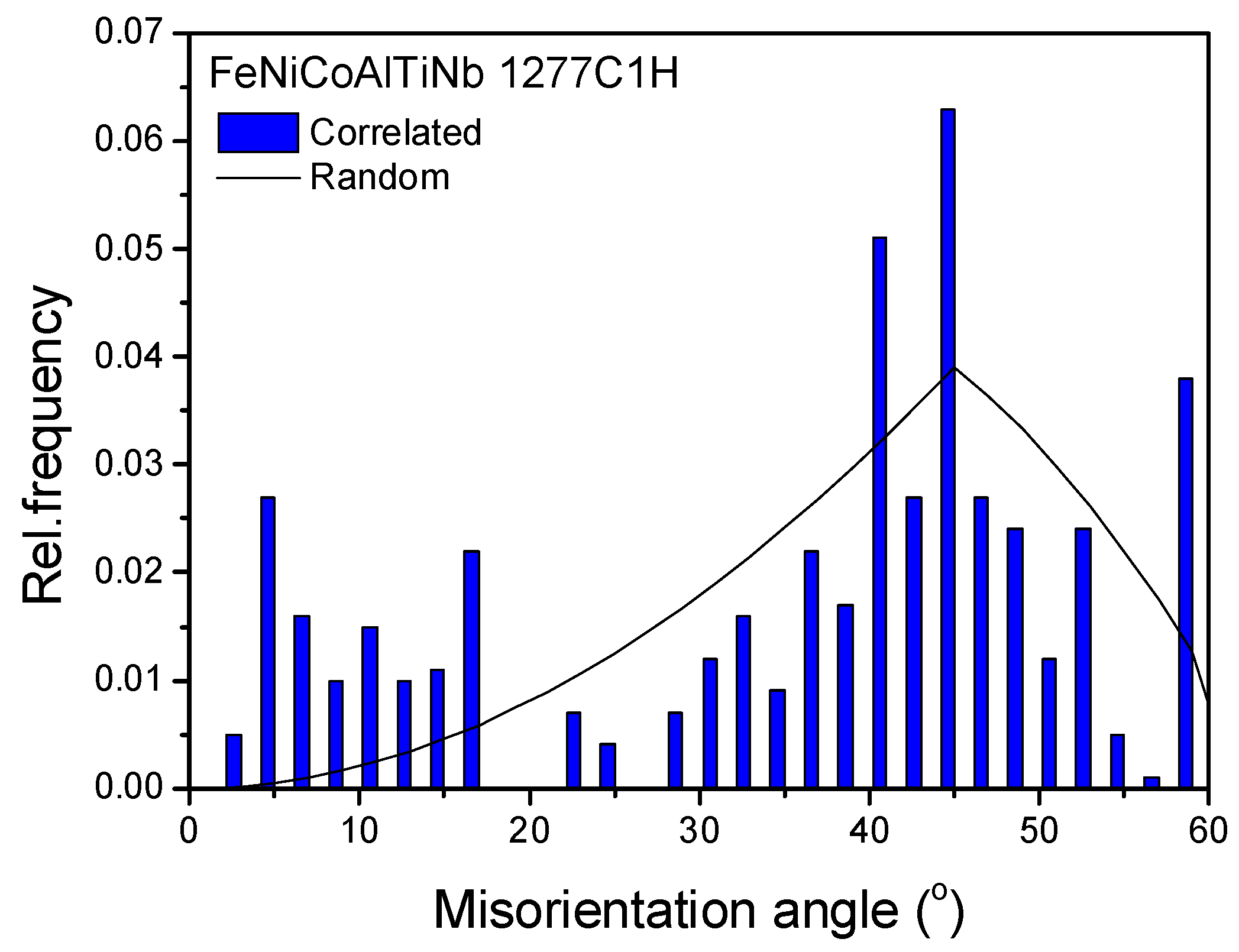
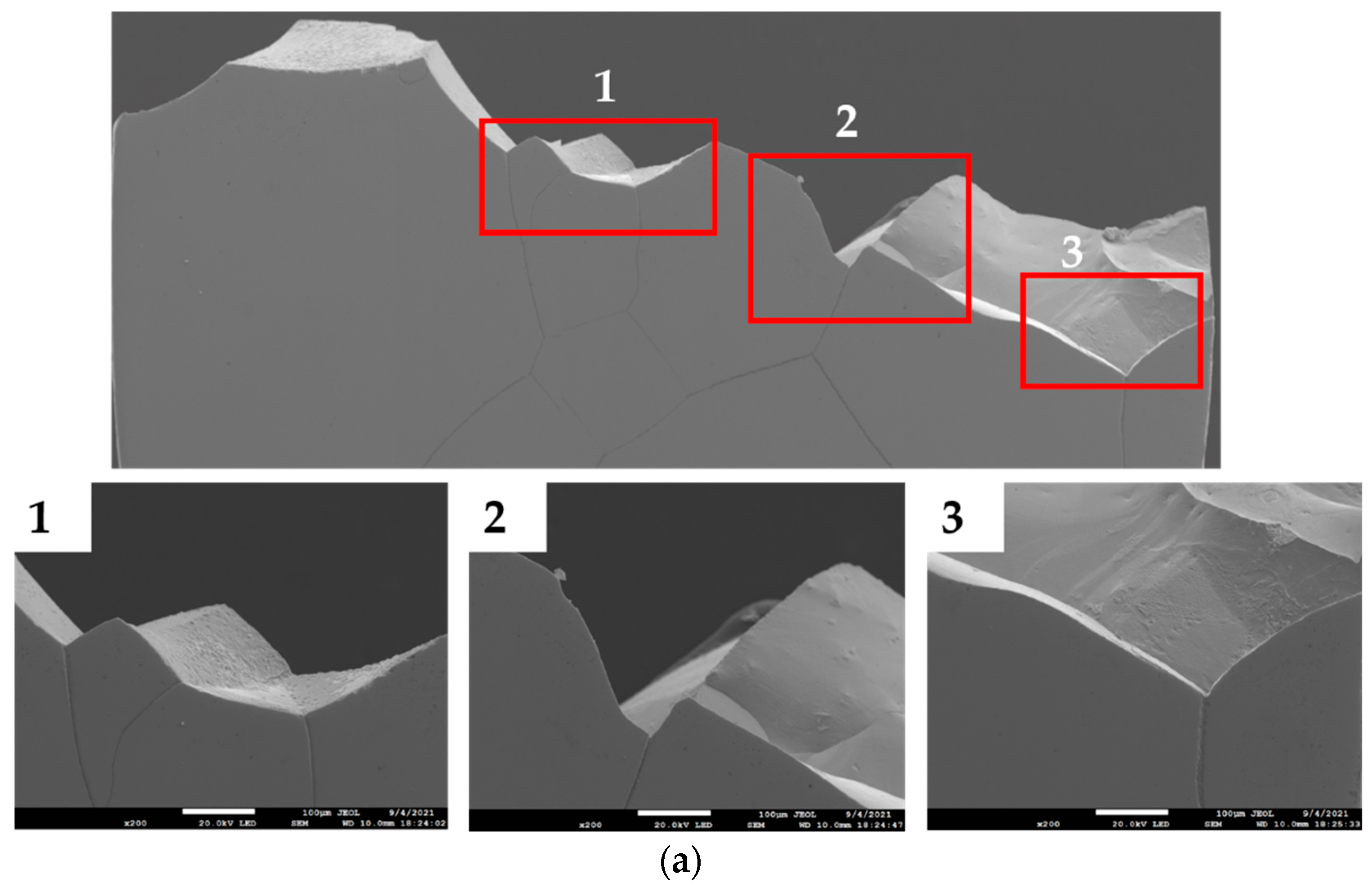
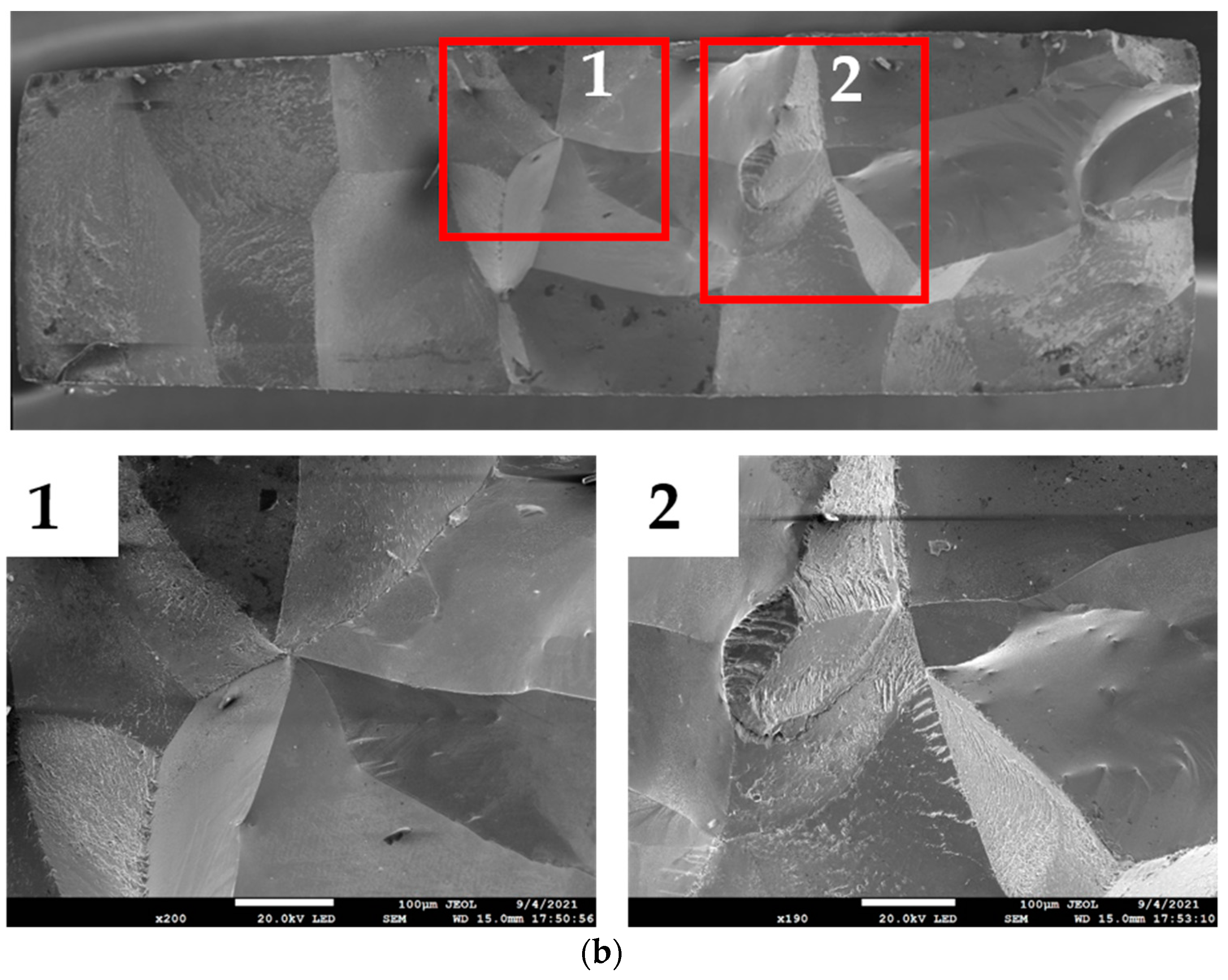
| Thermo-Mechanical Processing | Vickers Hardness (HV) |
|---|---|
| 97%CR | 430 ± 12 |
| 97%CR + 1277 °C–1 h | 260 ± 6.5 |
| 97%CR + 1277 °C–1 h + 600 °C–24 h | 462 ± 5.5 |
| 97%CR + 1277 °C–1 h + 600 °C–48 h | 510 ± 5 |
| 97%CR + 1277 °C–1 h + 600 °C–72 h | 552 ± 6 |
| Alloys | Transformation Temperature (°C) | Temperature Hysteresis (°C) |
|---|---|---|
| FeNiCoAlTaB (600 °C–72 h) | Af = −62 and Ms = −86 | 24 |
| FeNiCoAlTa (600 °C–90 h) | Af = −63 and Ms = −98 | 35 |
| FeNiCoAlNbB (600 °C–80 h) | Af = −30 and Ms = −70 | 40 |
| FeNiCoAlTiB (550 °C–24 h) | Af = −4 and Ms = −35 | 31 |
| FeNiCoAlTiNb (600 °C–24 h) | Af = −103 and Ms = −135 | 36 |
| FeNiCoAlTiNb (600 °C–48 h) | Af = −68 and Ms = −106 | 32 |
| FeNiCoAlTiNb (600 °C–72 h) | Af = −53 and Ms = −90 | 37 |
Publisher’s Note: MDPI stays neutral with regard to jurisdictional claims in published maps and institutional affiliations. |
© 2021 by the authors. Licensee MDPI, Basel, Switzerland. This article is an open access article distributed under the terms and conditions of the Creative Commons Attribution (CC BY) license (https://creativecommons.org/licenses/by/4.0/).
Share and Cite
Tseng, L.-W.; Chen, C.-H.; Chen, W.-C.; Cheng, Y.; Lu, N.-H. Shape Memory Properties and Microstructure of New Iron-Based FeNiCoAlTiNb Shape Memory Alloys. Crystals 2021, 11, 1253. https://doi.org/10.3390/cryst11101253
Tseng L-W, Chen C-H, Chen W-C, Cheng Y, Lu N-H. Shape Memory Properties and Microstructure of New Iron-Based FeNiCoAlTiNb Shape Memory Alloys. Crystals. 2021; 11(10):1253. https://doi.org/10.3390/cryst11101253
Chicago/Turabian StyleTseng, Li-Wei, Chih-Hsuan Chen, Wei-Cheng Chen, Yu Cheng, and Nian-Hu Lu. 2021. "Shape Memory Properties and Microstructure of New Iron-Based FeNiCoAlTiNb Shape Memory Alloys" Crystals 11, no. 10: 1253. https://doi.org/10.3390/cryst11101253






